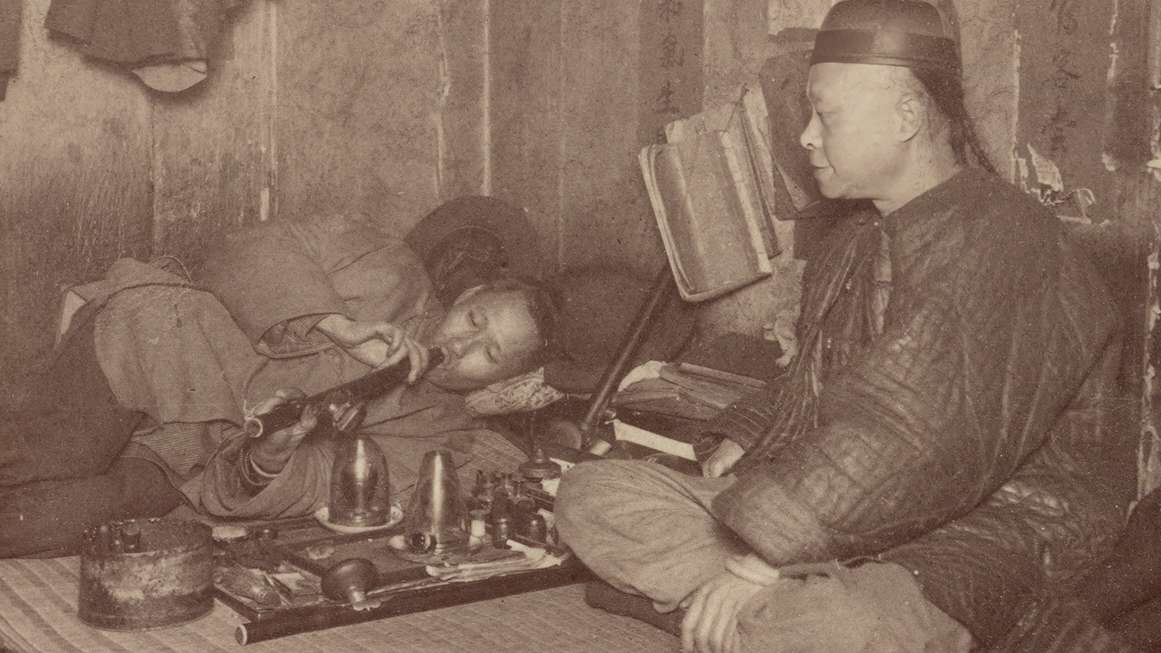At around 2 a.m. on Monday, December 6, 1875, a group of police led by Captain William Douglass descended on 609 Dupont Street in San Francisco. The individuals arrested included Fannie Whitmore, Cora Martinez, James Dennison, and Charles Anderson, as well as “two Chinamen who kept the place.”
The location, described as an “opium den” by The San Francisco Examiner, was the target of the first raid conducted under a new ordinance passed by the city’s Board of Supervisors on November 15. This ordinance prohibited the operation or patronization of places where opium was smoked.
The violation of this ordinance was considered a misdemeanor and could result in a fine ranging from $50 to $500, as well as a potential jail sentence of 10 days to six months. The individuals arrested were convicted on the same day and paid the minimum fine.
San Francisco’s ordinance specifically targeted opium smoking and did not address other forms of opium consumption, such as oral consumption or morphine injections. The law was aimed at curbing a habit associated with a minority group that was perceived as threatening to the majority population.
The ordinance was the first anti-drug law in the nation and set a precedent for future laws targeting substances deemed socially harmful, often based on fears associated with certain minority groups.
‘The Worst Class of People’
Testifying before the California Senate on Chinese Immigration, a San Francisco police officer named George W. Duffield claimed that the majority of Chinese immigrants in the city were opium smokers and that nearly every house had an opium den. He expressed strong negative views towards Chinese immigrants, describing them as “the worst class of people on the face of the earth.”
Another police officer, James R. Rogers, highlighted the increasing prevalence of opium dens patronized by both Chinese and white individuals. Despite efforts to curb the practice, opium smoking continued to persist in the city.
Concerns about opium dens and their clientele, including fears of race mixing and exploitation of white individuals, fueled ongoing efforts to crack down on opium use in San Francisco.
The San Francisco Examiner lamented the sight of individuals from different racial backgrounds succumbing to the effects of opium within these dens, emphasizing the dangers and social ills associated with the drug.
The majority of women working as prostitutes in the southern section of the city have been brought to their degraded state through opium use or association with opium users. The use of opium was a major problem in Salt Lake City, as evidenced by a raid where two women were found in a drug-induced state. Journalist Jacob Riis also described the plight of young women in New York City’s “Chinese quarter” who were enslaved by the drug.
The American Federation of Labor raised concerns about Chinese immigration in 1902, highlighting young girls under the influence of opium in Chinese laundries. The California Senate’s immigration committee described Chinese homes in San Francisco as extremely filthy, with opium fumes adding to the squalor.
Politicians like state Sen. Edward J. Lewis were disgusted by life in Chinatown, advocating for ordinances to remove the Chinese as a nuisance. The opium problem was seen as intertwined with the “Chinese problem,” leading to attempts to subjugate or drive away Chinese immigrants through various legal measures.
Large-scale Chinese immigration to the U.S. during the Gold Rush sparked resentment and hostility, with legislation aimed at limiting Chinese immigration and competition with white labor. Economic factors, such as the completion of the Pacific Railroad and the Long Depression, fueled anxieties about Chinese competition in the workforce.
Complaints about Chinese competition were amplified by labor unions and middle-class businessmen, who portrayed virtues like thrift and hard work as vices. Despite contradictions in portraying Chinese immigrants as both hardworking and opium addicts, nativists remained steadfast in their anti-Chinese sentiments. The article discussed how Celestials, a term used to refer to Chinese immigrants, were known for engaging in vices such as opium smoking, gambling, and prostitution, but also for their hard work and entrepreneurial spirit. They were seen as creating intense competition for American miners, mechanics, and tradesmen with their laundries, cigar shops, and vegetable stands. The article described their customs as “quaint and curious,” blending ingenuity with vices.
The San Francisco Chronicle detailed the prevalence of opium dens in the city, estimating hundreds in existence. The paper acknowledged that opium smoking was not universal among Chinese immigrants but was still a significant issue. It compared the effects of opium smoking to alcohol consumption, suggesting it was a slower form of poisoning.
The Chronicle expressed concern over the degradation of Chinese immigrants due to opium smoking and the perceived lack of interest in assimilating into American society. The article highlighted the need for a moral crusade against further Chinese immigration, leading to the eventual passing of the Chinese Exclusion Act of 1882.
The anti-Chinese sentiment extended to various regulations targeting Chinese immigrants, such as minimum space requirements for dwellings, restrictions on theater performances and laundry licenses, and bans on opium dens. These measures were often disguised as public health and safety concerns but were aimed at discriminating against Chinese immigrants. The discriminatory enforcement of these laws was later found to violate the 14th Amendment’s guarantee of equal protection. Legislators’ motives cannot be questioned in court to invalidate their acts. In contrast, the California Supreme Court blocked a Stockton ordinance criminalizing opium smoking gatherings, citing the law’s intrusion on individual rights. The court noted that while legislatures may declare vices as crimes due to their effects, such laws infringe on personal liberties. Despite this, California lawmakers passed laws criminalizing opium sales and possession, following federal efforts to prevent opium consumption.
The Smoking Opium Exclusion Act of 1909 was the first federal law targeting deliberate opium consumption, exempting medicinal use. This law aimed to address the sale of opium for smoking, distinct from its legal use in patent medicines. Congress had previously required labeling of patent medicines containing opium and other drugs, but did not regulate opium sales directly. Urged by international pressure, Congress quickly passed the import ban on smoking opium, despite doubts about its effectiveness and constitutionality.
Lawmakers recognized opium smoking as a societal ill, primarily associated with Chinese immigrants. Despite concerns that the import ban would not deter opium use, Congress pushed ahead with the legislation. While some legislators eventually supported the bill to combat opium smoking, others doubted its potential impact. Rep. Gaines, in particular, believed that eradicating the habit would require significant enforcement efforts beyond the proposed import ban. He suggested that if it were possible to eradicate opium smoking simply by implementing a law banning opium importation, it would have been done already. Despite concerns about constitutionality and practicality, most lawmakers remained undeterred. Representative James Robert Mann believed the bill, targeting a drug associated with foreigners deemed unworthy of citizenship, was a righteous and humanitarian measure, marking a significant step in advancing global civilization. The article was originally titled “‘Smoking Opium Is Not Our Vice.'”
Source link





